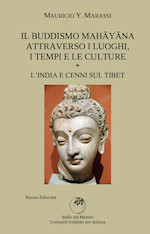To keep within the time allotted to me, I will give only one example among the many (22) that come to mind. In the Shōbōgenzō Zuimonki (23) Dōgen writes: «Therefore an ancient said: ‘Empty inside, following along outside’(24)». This phrase is drawn from the last chapter of the Zhuangzi (25). The first part of this sentence expresses the transcendental wisdom that zeroes in what is the highest potential of being human which is in letting oneself be empty. This deep and formless wisdom can be easily assimilated to Nāgārjuna’s middle way, which, in turn, derives from the middle way championed by Buddha in the Dhammacakkapavattanasutta (26). But the second part of the sentence quoted above, which we can traslate also as “meekly yielding outside” has nothing to do with the Buddhism we have mentioned above: the invisible one that lives in and through us all.
The suggestion that we should go meekly with the flowing reality instead of cutting through it and turning it over like a plough does to earth, is often doubtlessly very wise. However, with equal certainty, it is a product of the confucian-daoist ethics, based on ancestors’ veneration, on obedience to the established order, on the aversion to defying it, and on the attempt to go along with– rather than to distinguish oneself from – the eternal flowing mutation of each and every thing. It is the type of sentence that best expresses the principles of the social ethics dominant since centuries in the area influenced by the Confucian culture, whose sway over the far Eastern people make them seem to us particularly compliant and submissive.
This particular enculturation explains why, when we speak of the inner attitude that characterizes the life of a zen practitioner – of “kokoro”, as the Japanese say – we are always reminded that gratitude towards our instructors and obedience towards all elders are among its essential and universal imperatives. These are undoubtedly good suggestions, above all insofar as they contribute to maintaining peace in a closed and centralized community. But they are not at all universal. For instance, in the early Indian communities, the vow of obedience was mandatory only for those of very young age, who were entrusted to a tutor, upādhyāya o ācārya, before their ordination. The obedience to precepts was and is a personal matter. They are tools for monks’ liberation -this is the meaning of bhiksu pratimoksa. Quite another matter is the obedience to those rules that are mandatory because they are required for the smooth functioning of a monastery.
To conclude: sometimes what is presented as “buddhist ethics” is in reality Confucian, amoral and often nomocratic (27). The ethics that constitutes one of the three pillars of Buddhism is quite another thing (28). It is not made up of normative injunctions, but is the difficult search for virtue in everyday’s life. There is only one, firm, uncompromising commitment to friendliness towards everything and everyone. A dramatic example of this demanding form of ethics beyond formulae and norms is the story of how “Nanquan Puyuan cut the cat” mentioned, among others, by Dōgen in the Zuimonki (29), where, quoting from the Blue Cliff Records (30), he explains: «When the great-function [the universal, we could say] manifests itself no fixed rules exist».
I should like to point out that I insist that moral ethics, with knowledge and body practice, is a precondition for Buddhism to be universal, not because this is some kind of Buddhist dogma or because the Indian, or Western, influence over early Buddhism makes this implication unavoidable. It is what the experience of generations of men and women deeply, assiduously and unselfishly committed to religion tells us in the clearest possible terms.
For instance, we have all made this experience; with the heart full of hate, or after causing pain and having fought bitterly with our wives, or husbands, we practice a zazen that, for a longer or shorter period, is without universality, except for the universality of the ancient, endless prattling of our minds. Zazen practitioners realize that, in the deep (31), the spirit of maitrī, karunā and ahimsā is of the same substance as zazen and that zazen permeates our lives with the same fresh and light spirit. But also the opposite is true. It is that spirit present in our life that produces the open-mindedness required for our sitting and our living to be one with the universe. Instead, an immoral and evil life generate a zazen that, at best is some kind of physical exercise. Hate, greed and envy harden the soul.
From the religious point of view, evil is all that keeps us apart, all that encircles us in a sham segment of reality, cuts us off from the infinite and prevents us from melting into it. Self-centeredness, greed and attachment are drives that close in the area of “me”; they prevent this “me” from bursting all boundaries. Clearly, if we want to give a chance to this effort to free human nature from its limits, we must also give up those forms of behaviour and motivations that push in the opposite direction. As a result, generosity, kindness and goodwill are the normal virtues of a religious life. This is so simply because there is no other way. Or, better, because all other ways push us farther and farther away, instead of leading us nearer the sea in which we wish to immerse ourselves to be water in water.
Notes:
22) Another pertinent example is constituted by the almost uncritical assimilation of Judō (literally: “the way of softness”) into Zen Buddhism. Judō comes from Laozi, 老子 (or Daodejing, 道徳経), as rou dao 柔道 “[prevail by] giving in, yielding”. It is perhaps unnecessary to recall that Zen does not aim either at prevailing, or yielding or resisting.
23) Shōbōgenzō Zuimonki, 2-10.
24) I am quoting from Shohaku Okumura and Daitsu Tom Wright English translation: Shōbōgenzō Zuimonki, Sayings of Eihei Dōgen Zenji recorded by Koun Ejo, Kyoto Soto-Zen Center, Kyoto 1987. In Japanese this sentence reads as: “Shikareba konin no iwaku: uchi munashiku shite, soto shitagauto”, or: 然あれば 古人 の 云く:内ち 空しふ して、外したがふと.
25) Zhuangzi, cap. XXXIII, 6.
26) Setting the wheel of Dhamma in motion.
27) Legism or nomocracy, “fajia”, 法家, in Chinese.
28) For the moment we call it “moral or spiritual ethics” to distinguish it from the other.
29) Cf. Shōbōgenzō Zuimonki 1-6.
30) Biyan-lu, 碧巌録, third case.
31) “Oku”, 奥, i n Japanese.
Se volete, lasciate un commento.
You must be logged in to post a comment.







